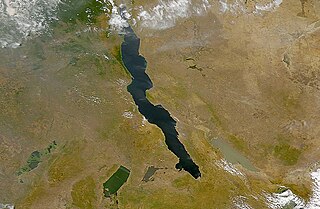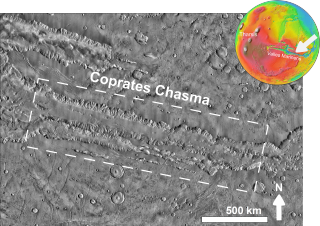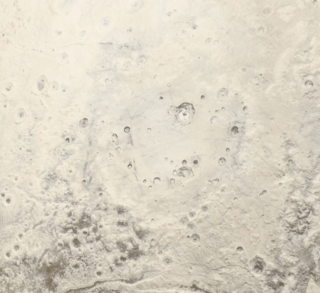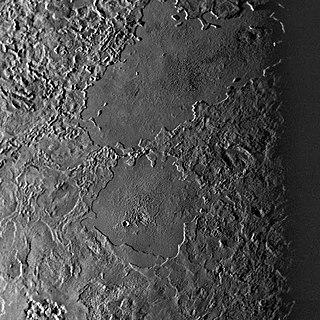
Charon, known as (134340) Pluto I, is the largest of the five known natural satellites of the dwarf planet Pluto. It has a mean radius of 606 km (377 mi). Charon is the sixth-largest known trans-Neptunian object after Pluto, Eris, Haumea, Makemake, and Gonggong. It was discovered in 1978 at the United States Naval Observatory in Washington, D.C., using photographic plates taken at the United States Naval Observatory Flagstaff Station (NOFS).

A rift valley is a linear shaped lowland between several highlands or mountain ranges produced by the action of a geologic rift. Rifts are formed as a result of the pulling apart of the lithosphere due to extensional tectonics. The linear depression may subsequently be further deepened by the forces of erosion. More generally the valley is likely to be filled with sedimentary deposits derived from the rift flanks and the surrounding areas. In many cases rift lakes are formed. One of the best known examples of this process is the East African Rift. On Earth, rifts can occur at all elevations, from the sea floor to plateaus and mountain ranges in continental crust or in oceanic crust. They are often associated with a number of adjoining subsidiary or co-extensive valleys, which are typically considered part of the principal rift valley geologically.

A cryovolcano is a type of volcano that erupts gases and volatile material such as liquid water, ammonia, and hydrocarbons. The erupted material is collectively referred to as cryolava; it originates from a reservoir of subsurface cryomagma. Cryovolcanic eruptions can take many forms, such as fissure and curtain eruptions, effusive cryolava flows, and large-scale resurfacing, and can vary greatly in output volumes. Immediately after an eruption, cryolava quickly freezes, constructing geological features and altering the surface.

The dwarf planet Pluto has five natural satellites. In order of distance from Pluto, they are Charon, Styx, Nix, Kerberos, and Hydra. Charon, the largest, is mutually tidally locked with Pluto, and is massive enough that Pluto and Charon are sometimes considered a binary dwarf planet.

The atmosphere of Pluto is the layer of gasses that surround the dwarf planet Pluto. It consists mainly of nitrogen (N2), with minor amounts of methane (CH4) and carbon monoxide (CO), all of which are vaporized from surface ices on Pluto's surface. It contains layered haze, probably consisting of heavier compounds which form from these gases due to high-energy radiation. The atmosphere of Pluto is notable for its strong and not completely understood seasonal changes caused by peculiarities of the orbital and axial rotation of Pluto.

Coprates Chasma is a huge canyon in the Coprates quadrangle of Mars, located at 13.4° south latitude and 61.4° west longitude, part of the Valles Marineris canyon system. It is 966 km (600 mi) long and was named after a classical albedo feature name. It was named from the classical Greek name for the Dez River in Persia.

Mordor Macula is the informal name for a large dark area about 475 km in diameter near the north pole of Charon, Pluto's largest moon. It is named after the black land called Mordor in J.R.R. Tolkien's The Lord of the Rings.

The geology of Charon encompasses the characteristics of the surface, crust, and interior of Pluto's moon Charon. Like the geology of Pluto, almost nothing was known of Charon's geology until the New Horizons of the Pluto system on 14 July 2015. Charon's diameter is 1,208 km (751 mi)—just over half that of Pluto. Charon is sufficiently massive to have collapsed into a spheroid under its own gravity.
Challenger Colles is a range of hills on Pluto near the eastern edge of Sputnik Planitia. Discovered by the New Horizons team in July 2015, It is named in honor of the Space Shuttle Challenger, which was destroyed with all seven crew lost on January 28, 1986. The name Challenger Colles was officially approved by the International Astronomical Union on May 27, 2022.

Vulcan Planitia, or Vulcan Planum, is the unofficial name given to a large plain on the southern hemisphere of Pluto's moon Charon. It discovered by New Horizons during its flyby of Pluto in July 2015. It is named after the fictional planet Vulcan in the science-fiction series Star Trek. The name is not approved by International Astronomical Union (IAU) as of 2024.

The Coleta de Dados Colles are a cluster of hills ("colles") on the smooth plains of Sputnik Planitia on Pluto. The hills are over 100 km from the major mountain ranges to the west, and appear to be blocks of water ice floating in the denser nitrogen ice of Sputnik Planitia. The hills were informally named on July 28, 2015, by the research team of the New Horizons mission after the first Brazilian satellite, the Satélite de Coleta de Dados. The ridge's name has yet to be recognized officially by the IAU.

Wright Mons is a large, roughly circular mountain and likely cryovolcano on the dwarf planet Pluto. Discovered by the New Horizons spacecraft in 2015, it is located southwest of Sputnik Planitia within Hyecho Palus, adjacent to the Tenzing Montes and Belton Regio. A relatively young geological feature, Wright Mons has attracted attention as one of the most apparent examples of recent geological activity on Pluto and borders numerous other similarly young features. Numerous semi-regular hills surround and partially construct the flanks of Wright Mons. Their nature remains unexplained, with few, if any, direct analogs elsewhere in the Solar System.

Burney, sometimes referred to as the Burney basin, is the second-largest known impact basin on the dwarf planet Pluto. With a diameter of over 290 kilometers and possibly up to 350 kilometers, it is the second-largest known impact basin on Pluto, after the Sputnik Planitia basin. Burney is the only impact basin with visible multiple rings known on Pluto and is thus classified as a multi-ringed impact basin, though its rings have been heavily eroded due to Burney's age.

Oz Terra is the unofficial name given to a major geological region on Charon. The Pluto-facing hemisphere of Charon is divided onto two primary regions; Oz Terra in the north and Vulcan Planum in the south. These regions are separated by a series of scarps near Charon's equator, particularly Serenity Chasma and Mandjet Chasma. The region was discovered by New Horizons during its flyby of Pluto in July 2015.

Mandjet Chasma is a chasma on Pluto's moon Charon. Mandjet Chasma is 385 km (239 mi) long, and about 5–7 km (3.1–4.3 mi) deep with an average width of 30 km (19 mi). The chasma is part of a global tectonic belt: a series of canyons, scarps, and troughs that traverse the face of Charon along the northern edge of Vulcan Planitia. The feature was discovered using stereoscopic processing of New Horizons images.

Dorothy is the largest known impact basin on Pluto's moon Charon. The crater was discovered by the New Horizons space probe in 2015 during its flyby of Pluto and its moons. It was named after Dorothy Gale from the novel The Wonderful Wizard of Oz. The crater is located near Charon's north pole, and overlaps the edge of Mordor Macula.

The climate of Pluto concerns the atmospheric dynamics, weather, and long-term trends on the dwarf planet Pluto. Five climate zones are assigned on the dwarf planet: tropics, arctic, tropical arctic, diurnal, and polar. These climate zones are delineated based on astronomically defined boundaries or sub-solar latitudes, which are not associated with the atmospheric circulations on the dwarf planet. Charon, the largest moon of Pluto, is tidally locked with it, and thus has the same climate zone structure as Pluto itself.

Caleuche Chasma is a Y-shaped chasma on Pluto's moon, Charon. Caleuche Chasma is 400 km (250 mi) long. The feature was discovered using stereoscopic processing of New Horizons images. At approximately 13 km (8.1 mi) deep, it is the deepest known feature on the natural satellite, and one of the deepest known canyons in the Solar System.

Leviathan Patera is a major cryovolcanic caldera on Neptune's largest moon Triton. Discovered by the Voyager 2 spacecraft in 1989, Leviathan Patera is located in Monad Regio and within Cipango Planum's western regions. Leviathan Patera is approximately 80 kilometers in diameter and may be the center of one of the largest cryovolcanic or volcanic edifices in the Solar System.

Tuonela Planitia is an elongated plain and probable cryolava lake on Neptune's moon Triton. Located in Triton's northern hemisphere within Monad Regio, it overlies part of Triton's unusual cantaloupe terrain. As with neighboring Ruach Planitia and the other walled plains on Triton, Tuonela Planitia is among the youngest features on Triton's surface.















